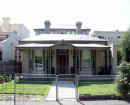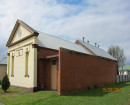MADAM BERRY NO 1
221 BEACONSFIELD ROAD SMEATON, HEPBURN SHIRE
-
Add to tour
You must log in to do that.
-
Share
-
Shortlist place
You must log in to do that.
- Download report
Statement of Significance
This record has minimal details. Please look to the right-hand-side bar for any further details about this record.
-
-
MADAM BERRY NO 1 - History
Heritage Inventory History of Site: The following history was extracted from The Berry Deep Leads: an historical assessment, CF&L, October 1986, Charles Fahey. The Madame Berry was the most famous and richest mine on the Berry Deep Leads system. Registered in 1878, on the Seven Hills Estate, the Madame Berry mine had 20 original shareholders. Work on the company's No.1 shaft commenced in 1879 and on its No. 2 shaft in 1883. The No. 2 shaft was bottomed at 462 feet and in 1886 £45,131 was reported as having been spent on the shaft. Besides wages, the money had been spent on a 90ft high poppet head; 90,000 bricks; one 26 inch cylinder pumping engine (5ft stroke); a 24 inch cylinder engine (5ft stroke) for winding; and two boilers (26ft x 6ft). A further two boilers were added in 1884, and three puddlers and also a secondhand engine purchased from Dykes Freehold. The capital works for the No. 2 shaft were funded from the enormous returns from the No. 1 shaft. By 1885 the drive from the No. 1 shaft had been extended some 2,000 feet and all hands were employed blocking at the extreme end of the mine. With over 250 employees, the mine was one of the largest industrial concerns in the colony of Victoria; only Melbourne's largest foundries - Austral Otis, for example - would have employed more hands. The No. 2 shaft proved to be equally as successful as the No. 1 shaft. In fact, yields in the late 1880s exceeded those of the mid 1880s. In 1888 a horse tramway was laid from No. 1 shaft to No. 2 shaft, and all the tailings were treated at No. 2 shaft. By the end of the year a 15-head stamp mill was treating cement. By 1890 the No. 1 shaft was closed and in 1895 the company was wound up. By this time the Madame Berry had produced 307,312 ounces of gold and paid dividends and royalties of £983,770. The last balance sheet in the defunct company file for April 1887 gives the total expenses up to that date of £700,629Significance In the history of Victorian gold mines the Madame Berry is unquestionably one of the more important mines. As a gold producer and dividend payer it was only rivalled by the Long Tunnel Extended in Walhalla, the Garden Gully United in Bendigo and the Albion Band of Hope Consols in Ballarat. The Madame Berry also represented the most advanced technology of its day. The plant at the mine was more extensive than most city factories, and sinking through drift was a major engineering feat. As an employer Madame Berry had few rivals in Australia at the mid 1880s.Heritage Inventory Description
MADAM BERRY NO 1 - Heritage Inventory Description
Madame Berry No. 1 shaftMullock heap - Mullock heap with single dumping line.Tailings - Extensive spread of slum Madame Berry No. 2 shaft Mullock heap - Large mullock heapSlum pond - party quarried
Heritage Inventory Significance: The site has:Historical significance - one of the State's most important mines for both economic and technological reasonsSocial value - mullock heap is a landscape featureNetwork values - part of Berry network of significant sitesSIGNIFICANCE RANKING: Regional
Recorded by: David Bannear
Heritage Inventory Site Features: No. 1 - mullock heap and tailingsNo. 2 - mullock heap and slum pond
-
-
-
-
-
MADAM BERRY NO 1
 Victorian Heritage Inventory
Victorian Heritage Inventory -
LORD HARRY MINE
 Victorian Heritage Inventory
Victorian Heritage Inventory -
LONE HAND 2 MINE
 Victorian Heritage Inventory
Victorian Heritage Inventory
-
-







